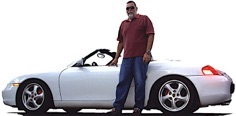
Published in the August 2014 issue of “Die Porsche Kassette”
Underdriving (or spinning at a slower rate) the secondary systems in your car, such as the Alternator, the Air Conditioning Compressor, the Water Pump and the Power Steering Pump by using a smaller than OEM crankcase pulley has been successfully used for decades by drag and road racers.
Underdriving the accessories does not add power to the engine, it frees up power that is normally wasted on overdriven accessories.
But let’s not get ahead of ourselves. First things, first.
In the following photo you can see the parts that make up the subsystems in a modern Porsche engine:
1.- Alternator
2.- A/C Compressor
3.- Crankcase Pulley
4.- Water Pump
5.- Tensioner Pulley
6.- Idler Pulleys

All of these sub-systems are driven by the main crakshaft pulley (#3 above) via one serpentine belt that snakes around each one of the subsystem’s pulleys and the main pulley. Obviously it takes power to spin each one of those subsystems and that power comes from the engine.
It all started with the earlier Boxsters and Caymans that would seriously Autocross; and I mean seriously, with dedicated AX tires, etc.
These cars worked the Power Steering Pump so hard that they would literally melt the plastic power steering oil lines.
Autocrossers started replacing the plastic lines with aluminum ones and started installing heat dissipators, but they would still boil the fluid, so the idea of under-driving the pump was put to the test and ... it worked!
But... there are always people that have their doubts, so here is a Q&A to take care of those doubts:
Q: “Do underdrive pulleys really give me more power?”
A: Yes. Undedrive pulleys free up power lost to parasitic drag, so they do deliver
more HP. They are also generally lighter in weight than the OEM which
allows the engine to spin less rotational mass. In fact, underdrive pulleys are
one of the cheapest forms of making HP.
Q: “How much HP can I get by installing an underdrive pulley”
A: In a wasserboxer (water-cooled Carrera, Cayman or Boxster) you can expect
to get back 7-10 HP.
Q: “Don’t underdrive pulleys cause charging problems?”
A: Porsche builds into their electrical systems quite a bit of extra capacity for
situations of very high electrical demand, such as driving on a frigid winter
night with the high beams on, wipers and defrosters going, as well as seats
and steering wheel heaters all while listening to your favorite tunes on the hi-fi
Bose audio system. In other words, a very powerful electrical system is built
into our cars with quite a bit to spare.
An older Porsche with a less than optimum charging system and a small weak
battery may have a problem with an underdrive pulley as could some cars with
monster audio installations that need more wattage than what’s required to
power a small city, but the vast majority of modern Porsches will never notice
a difference with their electrical, A/C, power steering or cooling systems when
they install an underdrive pulley.
Q: “Won’t underdrive pulleys cause the engine to overheat?”
A: Again, in the vast majority of modern Porsches there is enough reserve
cooling capacity to use an underdrive pulley safely. It is true that underdriving
the water pump causes the coolant to spend more time in the engine where it
will absorb more heat, but by the same token, the same coolant will also spend
more time in the radiators which will allow for the extra heat to dissipate
making it awash.
Q: “Are there any additional benefits to using an underdrive pulley?”
A: In high RPM situations such as racing or DE events at the track, an underdrive
pulley can prevent cavitation by the water pump. When the impeller of the
water pump cavitates, it actually spins too fast to push coolant. Coolant needs
dwell time in the radiators to lose enough heat before returning to the engine
to do it all over again.
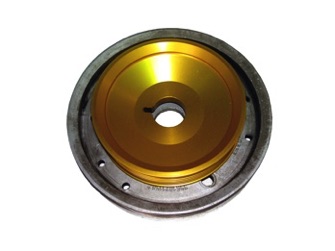
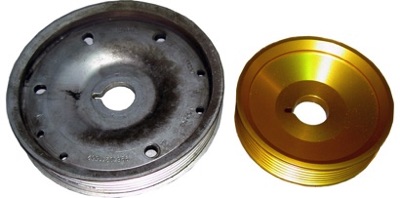
Here you can see a comparison of the OEM (6” diameter - aluminum) main pulley with one of the most popular underdrive pulleys (4” diameter - gold anodized) on the market.
Q: “How hard is it to install?”
A: It’s actually quite simple.
It may take 30 - 45 minutes.
You’ll have to gain access to
the pulley side of the engine.
In the Carreras it will be towards
the rear of the car. You’ll have
to remove the air filter box.
In the Boxsters and Caymans it
will be towards the front of the car and can be accessed through the removable firewall behind the seats.

•Remove the belt by loosening
the tensioner pulley
•Remove the lower idler pulley
(one bolt)
•Remove the main pulley (one
bolt)
•Grind or cut off 1/2” of the TDC
marking boss on the engine
•Install the new underdrive pulley
(one bolt)
•Install the idler roller removed
before (one bolt)
•Install the (smaller) belt (most
likely supplied with the
underdrive pulley kit)
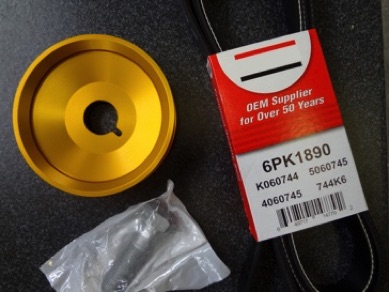
Q: “How much do they cost”
A: A high-quality underdrive pulley kit costs between $200 - $300
A word of caution:
When purchasing an underdrive pulley, make sure that it is a quality-made product. There are some cheap ones on the market and you generally get what you pay for.
An underdrive pulley needs to be made from lightweight but very strong material. It needs to be precisely machined so that it perfectly aligns with the other pulleys in the engine and it needs to allow the belt to seat properly, especially poly-ribbed belts, such as the ones in our Porsches.
Generally these pulleys are sold as a kit containing the underdrive pulley, a new fastening crankshaft bolt, threadlocker and a new (slightly shorter than OEM) belt.
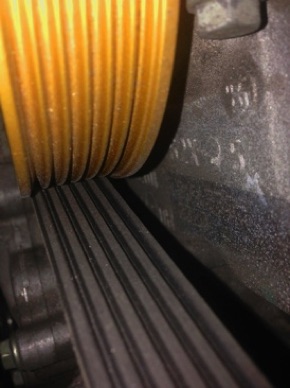
I have personally used an underdrive pulley for over 15 years in my ’98 Boxster with now over 250,000 miles without any issues whatsoever even in the South Florida heat and humidity.
For more information on underdrive pulleys and more, please visit my website: www PedrosGarage.com.
Happy Porsche’ing,
Ⓒ2014 Technolab / PedrosGarage.com

